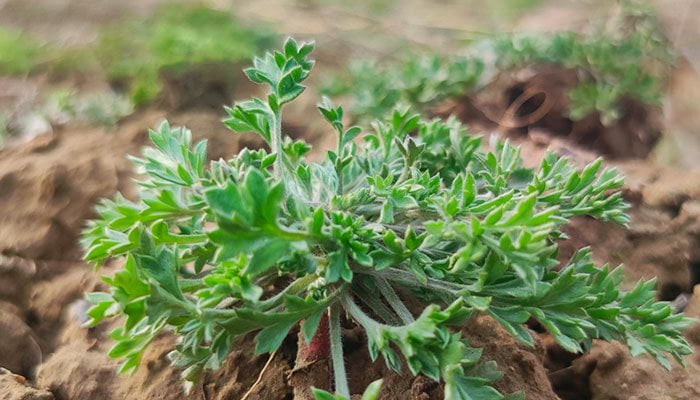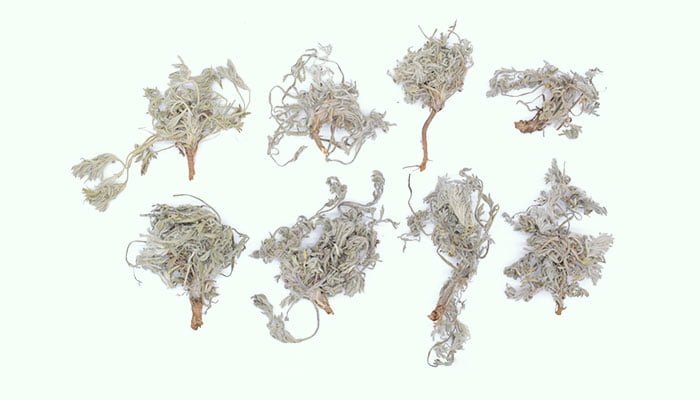What Is Yin Chen
Yin Chen also known as Yin Chen Hao or Herba Artemisiae Scopariae is the above-ground part of Artemisia scoparia Waldst et Kit or Artemisia capillaris Thunb, which is an herb belonging to the family Compositae. It is a relatively practical and common Chinese herbal medicine, which first appeared in <Shennong Ben Cao Jing> in the late Western Han Dynasty (around 100 BCE).
There are about 478 species of Artemisia, which are mainly distributed in temperate, cold temperate, and subtropical regions of Asia, Europe, and North America. Only a small number of species are distributed in Africa, South America, and Oceania. Some of these species are medicinal, such as Artemisia Annua, A. argyi Levl.et Vant, A. absinthium, A. scoparia Waldst et Kit, and A. capillaris Thunb.
A. scoparia Waldst et Kit is commonly known as virgate wormwood, capillary wormwood, or oriental wormwood. They often grow on hillsides, forest edges, roadsides, grasslands, and wastelands below 3,800 meters above sea level.
They are widely distributed in temperate and subtropical regions of Eurasia. They are annual or biennial in northern temperate and alpine regions, and perennial in slightly warmer regions.

Artemisia capillaris Thunb is a perennial subshrub-like herb. They often grow in moist sandy land along river banks, roadsides, and low hillsides in low-altitude areas.
They are distributed in China, Japan, South Korea, India, Pakistan, Thailand, Vietnam, Cambodia, Malaysia, and the Philippines.
Usually, people harvest the seedlings of A. scoparia Waldst et Kit, or A. capillaris Thunb in spring when they are 6-10cm high or harvest them in autumn when the buds grow to the beginning of the flowers, remove their impurities and old stems, dry them in the sun, and make them into Chinese herbal medicines.
Yin Chen contains 6,7-dimethylesculetin, 7-methylesculetin, 6-methylesculetin, 6-methoxycoumarine, 7-methoxycoumarine, 6,7-dihydroxycoumarin, isosabandin, sabandins A, sabandins B, capillarin, luteolin, genkwanin, circimaritin, isoarcapillin, arcapillin, cirsilineol, quercetin, eupalitin, eupatolitin, rhamnocitrin, isorhamnetin, capillarisin, kaempferol-3-glucogalactoside, quercetin-3-d-robinoside, rutin, quercetin-3-glucogalactoside, chlorogenic acid, caffeic acid, salicylic acid, volatile oils, and terpenoids.
Generally, the grayish-white, tender, and soft Yin Chen with a strong fragrance is preferred.
According to the Chinese Pharmacopoeia, the medicinal nature of Yin Chen is slightly cold, with a bitter and pungent taste. It has a certain therapeutic effect on the pathological changes of the spleen, stomach, liver, and gallbladder meridians.
In traditional Chinese medicine, it is often used to clear damp-heat, normalize gallbladder to cure jaundice, and treat hyperbilirubinemia, ABO Incompatibility, cholecystitis, acute pyogenic cholangitis, intrahepatic cholestasis of pregnancy, colpitis, eczema, psoriasis, icteric hepatitis, virus hepatitis, non-alcohol fatty liver disease, cirrhosis, drug-induced liver injury, chronic liver failure, hepatocellular carcinoma, pancreatitis, metabolic syndrome, and type 2 diabetes.
There are more than 200 kinds of traditional Chinese medicine prescriptions containing it, such as Yin Chen Hao Tang, Yin Chen Wu Ling San, and Yin Chen Si Ni Tang.
Benefits
- Anti-inflammation, suppressing LPS-induced cytokine production and NLRP3 inflammasome activation in macrophages and alleviating carrageenan-induced acute inflammation in mice [1].
- Attenuating the body temperature of rats with fever caused by 2,4-dinitrophenol or yeast [2].
- Improving pain threshold, prolonging the nociceptive time of mouse hot plate experiment, and reducing the number of writhing in mice induced by acetic acid [2].
- Inhibiting a-glucosidase activity and lowering postprandial blood glucose levels [3].
- Inhibiting weight gain and reducing serum triglyceride (TG), total cholesterol (TC) and low-density lipoprotein cholesterol (LDL-c) levels in mice fed a high-fat diet [4].
- Reducing acetaminophen or CCL4-induced liver injury in mice and protecting the liver [5].
- Promoting bile secretion and increasing the excretion of solids, bile acid, and bilirubin in bile.
- Clearing damp-heat in the spleen, stomach, liver, and gallbladder, and treating oliguria and jaundice caused by damp-heat.
- Treating fever, fatigue, oppression in the chest, abdominal distension, and difficult urination caused by damp-warm or summer-heat and damp.
- Relieving itching and treating eczema and urticaria caused by interior retention of damp-heat.
- Its essential oils exhibited a strong antioxidant and radical scavenging activity against hydroxyl ion (OHradical dot) and hydrogen peroxide (H2O2) [6].
- Its extract can inhibit the secretion of HBsAg and HBeAg or the replication of HBV DNA [7].
- Inhibiting the growth of hepatoma cells SMMC-7721 cells, HepG2 cells, Huh-7 cells, HeLa cells, and mouse liver cells, and promoting the apoptotic process in cancer cells like the human leukemia HL-60 cells or nasopharyngeal carcinoma cells (CNE-2 cells) [8].
- The hot water extracts of A. scoparia attenuated an increment of blood pressure in SHR (spontaneously hypertensive rats) via the enhancement of VEGF (Vascular endothelial growth factor) expression and the suppression of RhoA (ras homolog gene family member A) expression by reduced ACE (angiotensin I converting enzyme) activity and angiotensin II production [9].
Combinations
- It can be used in combination with Zhi Zi (Fructus Gardeniae) and Da Huang (Radix et Rhizoma Rhei) to treat jaundice caused by damp-heat.
- It can be used in combination with Fu Ling (Poria), Bai Zhu (Rhizoma Atractylodis Macrocephalae), Zhu Ling (Polyporus), Gui Zhi (Ramulus Cinnamomi), Ze Xie (Rhizoma Alismatis), etc. to treat damp-heat style jaundice more damp with less heat and difficult urination.
- It can be used in combination with Zhi Gan Cao (Radix Glycyrrhizae Preparata), Gan Jiang (Dried Ginger), Fu Zi (Radix Aconiti Lateralis Preparata), etc. to treat viral hepatitis and yin jaundice.
- It can be used in combination with Hua Shi (Talcum), Huang Qin (Radix Scutellariae), Mu Tong (Caulis Akebiae), etc. to treat fever, fatigue, oppression in the chest, abdominal distension, difficult urination caused by damp-warm or summer-heat and damp.
- It can be used in combination with Huang Bai (Cortex Phellodendri), Ku Shen (Radix Sophorae Flavescentis), Di Fu Zi (Kochiae Fructus), etc. to treat eczema and urticaria caused by interior retention of damp-heat.
Side Effects
- At present, there is no literature report that Yin Chen has toxic effects, and no data is showing that taking it at the prescribed dose can cause serious adverse reactions.
- It can be irritating to the gastrointestinal tract when taken in large doses.
Precautions and Warnings
- The dosage of Yin Chen should be controlled at 6-15g.
- It can be made into decoctions, pills, capsules, or lotions.
- People who are allergic to Yin Chen should not take it.
- It should not be taken at the same time as medications containing chloramphenicol.
- Patients with jaundice due to blood stasis should not take it.
- Patients with a sallow complexion due to blood deficiency should not take it.
- Pregnant and breastfeeding women should take it under medical supervision.
